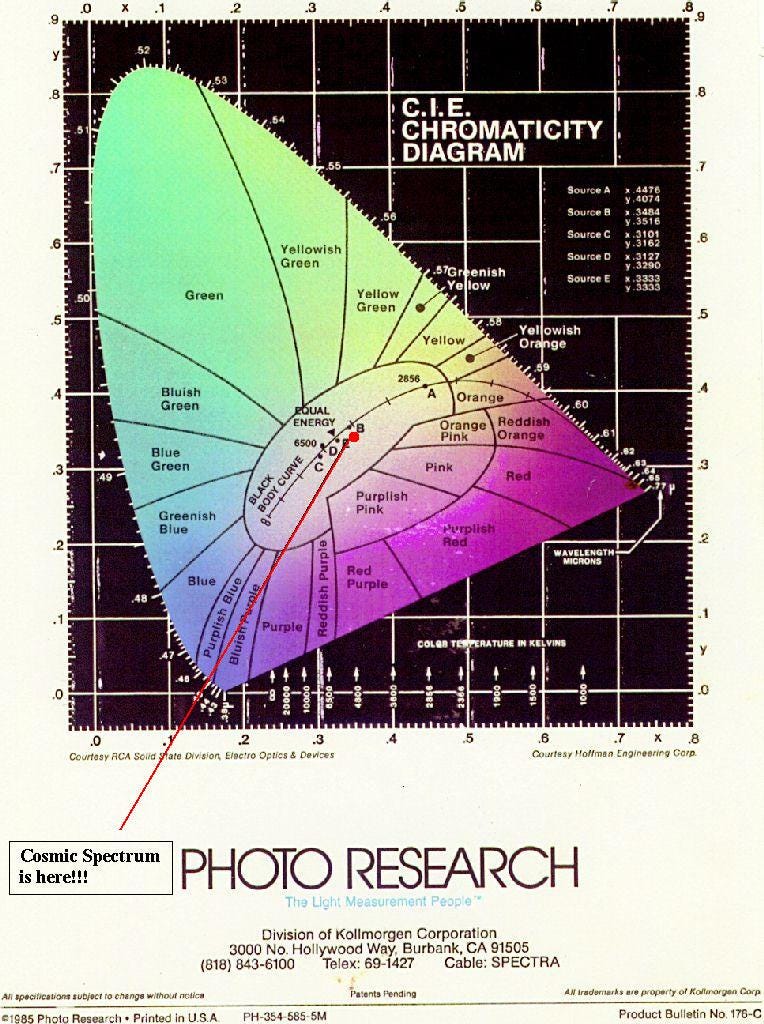Some colors are also temporalities, hues determined as much by time as by pigment or wavelength. I’ve dubbed these transient colors “chronochromes” (not to be confused with the French film color system of the early 20th century). Welcome to a series exploring some of the tints that get my imagination tingling.
What better place to begin than with the aggregate color of the KNOWN UNIVERSE?? (Spoiler alert: for a halcyon couple of weeks, we thought it was the minty green of Buick Skylarks1 and guest bathroom tiles from the 1950s. Sadly, it is not.)
Tonight, look to the west (if you’re in the Northern Hemisphere) and you might see the constellation Cygnus, the swan, winging over the galactic river of the Milky Way. At his beak glows a double star called Albireo.
To the naked eye, it looks like a single, bright, but nondescript, point of light. The fault is not in our stars, in this case, but in our vision. The cones of our retinas, our color detectors, falter in dim light and the rods that take up the slack are effectively colorblind. But look through even a simple telescope, and Albireo’s two stars radiate a warm amber and a pilot light blue. The cosmos is a jewel box spilled all around us.
As you may recall from the era of elementary school solar system dioramas, the age of a star can be approximated by the color of its light. Two decades ago, astronomers from Johns Hopkins analyzed the light from over 200,000 galaxies2 reaching out several billion light years to better understand the history of when star systems were formed.
They mapped these wavelengths onto a Cosmic Spectrum, approximating the color the human eye would see at each wavelength. Envision all the light in the universe passing through a prism; the resulting rainbow accurately reflects the intensity of each color in proportion to its intensity in the universe.
Within this spectral analysis, specific patterns of lines and bands act like fingerprints, revealing the absorption and emission of particular elements and thereby the temperature and age of the star from which the light traveled. Researchers found that most stars were formed around 5 billion years ago and that the rate at which stars are born has declined precipitously since then.
As an amusing afterthought, the researchers speculated the “average” color of the universe; if you opened a box labeled “UNIVERSE” and could see all the light at once, what color would it be? At first, they proposed a perky, optimistic sea foam green dubbed “Cosmic Spectrum Green” — proof of intelligent design if there ever was any.
Tragically, a computer error had misplaced the “white point” — the point at which light appears white given the environment that it is viewed in — and the Johns Hopkins team had to walk back the celestial turquoise. In its stead, the accurate aggregate color of the known universe is a warm white edging toward a much maligned hue: beige.
In an effort to avoid a bland branding of the entire universe, the researchers crowdsourced name suggestions “as long as it’s not beige!” And let me tell you: whatever faith I lost in Cosmic Spectrum Green’s fall from grace returned to me tenfold upon hearing the suggestions.
They included Big Bang Buff, Skyvory, Cosmic Khaki, Astronomer Green as a dig at the initial color mixup, Univege, and my personal favorite, Primordial Clam Chowder. Eventually they settled on Cosmic Latte as a simultaneous nod to Galileo’s mothertongue, our own Milky Way galaxy, and the astronomers’ caffeine addiction.
The more I think about it, the more I uncover an affection for this color. Sure, it’s the go-to neutral for high-end children’s clothing and generic apartment buildings alike. But it’s also a color that pulsates with life. It’s the color of thick, raw milk and sturdy bone. Sheep’s fleece and sand dollar.
It’s the color of a moment in time when on one small, blue planet among the countless host of planets hurtling within countless galaxies, the conditions were juuuuust right for some apes to get notions, make fire, and figure out the color of the universe.
Before (by orders of billions), the universe’s color was a cooler blue illuminated by young stars. And since the bulk of stars will age together, a cohort of red giants, the color of the universe will progressively skew more red.
“Eventually all stars will disappear and nothing will be left but black holes,” the researchers explain. “These too will eventually evaporate via the Hawking process and nothing will be left except for old light, which will itself redden as the Universe expands forever.”
But for now, there’s Cosmic Latte. I’ll gladly drink to that.
Fun Things and Other Voices
Wish you could hear the color of the universe? Hopefully a playlist will suffice. Here’s a fun playlist inspired by Cosmic Latte curated by Carly Bogdajewicz.
Want to take more frequent deep dives into astronomy?
by has the knowledge and enthusiasm to guide you through the cosmos. Still hungry for more? Check out for big ideas delivered in a delightful way (sometimes featuring talking dinosaurs).Also, if you’re wondering why black isn’t the predominant color of the universe, you can find out more with these cosmic Q&As.
So, my brilliant magpies, can you think of any Chronochromes you’d like to see explored? Tell me in the comments!
https://www.astro.ljmu.ac.uk/~ikb/Cosmic-Spectrum.html











So poetic, so cosmic. I like that beige latte color. I can live with that.
It was wonderful to break my break from this platform with this brilliant analysis. Tonight, I will drink of the cosmic latte thanks to you.